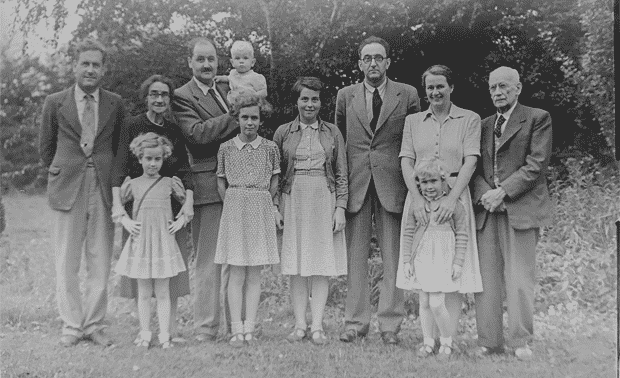Sign up for the Family Tree Newsletter! Plus, you’ll receive our 10 Essential Genealogy Research Forms PDF as a special thank you.
Get Your Free Genealogy Forms
"*" indicates required fields
Table of Contents
What is a surname?
Surnames, also called family names and last names, are names added to the end of a person’s first or “given” name. The creation and adoption of surnames are largely based on culture and nationality. It’s believed the Chinese adopted the practice of hereditary family names as early as 2852 BC. England began relying on them around 1000 AD. In some cultures, Filipino and Turkish for example, last names weren’t readily used until as late as the 19th and 20th centuries.
More Resources
BRITANNICA
HALL OF NAMES
Where does your last name come from?
Surname origins tend to fall into one of four categories: patronymic (named from the father), occupational, nickname or place name. According to Elsdon Smith, author of American Surnames (Genealogical Publishing Co.), a survey of some 7,000 last names in America revealed that slightly more than 43 percent of our names derive from places, followed by about 32 percent from patronymics, 15 percent from occupations, and 9 percent from nicknames.
In your genealogy research, you’ll likely come across most of the four main categories of surnames:

Patronymics
Virtually every culture seemed to have some form of patronymic system, though some relied on it more heavily than others. In Ireland, the Scottish highlands, Wales and Spain the majority of names are patronymics; likewise in Scandinavia, though these have additional complications.

Occupational names
Surnames derived from occupations figure prominently on the list of America’s most common surnames, including Smith, Miller, Taylor, Clark, Walker, Wright, Baker, Carter, Stewart, Turner, Parker, Cook and Cooper. During the Middle Ages, it was useful to distinguish John the baker from John the tailor. The occupations were fairly common across Europe, and their use as surnames took on a decidedly local flavor.

Place names
Surnames sprang from place names in several ways: when someone was associated with or living near or by a particular hill, brook, bush, dale, valley, island, bridge, meadow, road or village; when the person was known as coming from a particular locality; and when the individual owned a manor or village. Place-derived family names dominate in England and they’re common in Germany and France.

Nicknames
The word “nickname” is derived from “an eke name,” or added name. In a sense all surnames began as extra names, so technically speaking, all surnames are nicknames of one sort or another. In our classification scheme, hereditary family names based on nicknames often describe an ancestor’s appearance (stature, hair, eyes, complexion, size), a characteristic or trait (strong, bold, brave), financial status, habits or special skills. Nickname-based names were popular in Italy and Portugal. Sometimes, this form was mixed with the patronymic system as in the Italian D’Onofrio, “son of a giant.”
Often the lines blur between the categories. Take the example of Green. This name could come from one’s clothing or given to one who was inexperienced. It could also mean a dweller near the village green, be a shortened form of a longer Jewish or German name, or be a translation from another language.
Specific ethnic groups often had their own naming conventions. In Russia, -vich is a common suffix, as in Ivan Nikolayevich (Ivan, son of Nikolay). In Nordic countries, -son or -sen indicates “son of.” The suffix -dotter, -dottir or -datter means “daughter of.” Gaelic patronymic surnames start with Mc, Mac, O or Fitz. (There’s no factual basis to the belief Mac is Scottish and Mc is Irish — Mc is just an abbreviation of Mac.)
Some families have been in America so long, modern members don’t have a clue where the name came from. How to unravel the tangle? In some cases, as with Cooper, Wright, Brook, MacKenzie and O’Connor, we can guess the meanings. For others, such as Samora, Deeming and Winton, the waters are muddier.
Barbara Krasner-Khait and Nancy Hedrickson
More Resources
FINDMYPAST
THOUGHT CO.
How to find out what your last name means
Despite their importance to genealogy, some surnames didn’t come along until fairly recently, and genealogists are glad their families finally adopted these identifiers. But the value of last names to family historians doesn’t stop there. You can open the door to even more genealogical finds by using these strategies for learning what your last name means:
1. Research surname origins and naming conventions and traditions
Learning your surname’s meaning is fascinating and might even point you to an ancestral homeland. There are countless surname books (such as the Dictionary of American Family Names) and web pages you can search, including Adopted.com/CousinConnect, Ancestry, Cyndi’s List, FamilySearch, Forebears, Geneanet, GenForum/Genealogy.com, GenGateway, RootsWeb and Surname Web.
2. Ask relatives
Another resource for family name history information is to ask any and all relatives who might know. I was told that a family with the name of Kean was related to me. It struck me as a strange Jewish surname. My father’s cousin told me the original name was Kanovsky. I had Max Kean’s naturalization papers with the ship’s name and arrival date in New York, but I couldn’t find him on a passenger list. After a six-year search, I managed to find his daughter-in-law and she revealed that the original name was Dvorkin, my great-grandmother’s maiden name. Apparently, Max stopped briefly in England on his way to America from Russia. He found work in a tailor’s shop in London where his boss told him he had to change his name to something customers could pronounce. He saw the actor’s name Edmund Kean on a Piccadilly Circus marquee, and thus became Max Kean.
Barbara Krasner-Khait
3. Study family trees and profiles with the same name
Look at information on profiles in trees with your name, which may be starting places for your research. Ancestry.com’s Last Name Meaning tool also can give you information on profiles in its tree with your name, which may be starting places for your research. Again, use this data as clues, not absolute answers.
4. List surname variations and misspellings
Your relative may have spelled his own name various ways in records, and branches of the family may have used different versions of a name. In addition, in the 1800s and earlier, many people couldn’t read, write or spell. For those who could write, phonetic spelling was common: A census taker hearing a name pronounced in an unfamiliar accent probably didn’t spell it the way your ancestor did. For example, my North Carolina ancestor wrote Ferginny for Virginia.
Keep a list of common misspellings and variations of your ancestor’s surname. We’ve got a free Surname Variant Chart to help you keep track of them. Searching for variations and phonetic spellings is especially important in the census and other indexes: If you’re not on the alert for every conceivable spelling variation, you could miss your ancestor. It’ll help to keep a list of your surnames and all the variations you can think of.
5. Look into DNA surname studies
The link between the Y-chromosome and surnames—barring “nonpaternity events,” our male ancestors passed both their Y-DNA and their surnames to their sons—makes genetic genealogy helpful for determining whether two men share a common male-line ancestor within recent history.
If you’re a woman, note you’d need to have a male relative who inherited the surname through male lines take the test. By comparing your test results to the results and research of others in the study, you’ll get an idea of where your family members with this surname originated.
Autosomal DNA tests, offered by companies such AncestryDNA and MyHeritage DNA, can also be helpful, since these companies provide DNA matches as well as lists of ancestral surnames you and your matches share. Expert genetic genealogist Blaine T. Bettinger compares the pros and cons of autosomal and Y-DNA testing in this article.
If you join a DNA surname study with lots of participants and a well-documented lineage back to England, Ireland or Scotland, your chances of making a match are high. In that case, DNA testing can leapfrog you back 100 or more years. Even a negative result can help: My family believed most Hendricksons descended from “the frontier Hendricks” family, but DNA proved otherwise.
If you join a DNA surname study with only a handful of participants and find no matches, it’s generally because the study doesn’t yet have enough people to test against, or the family had an adoption or other undocumented parentage.
Keep in mind, though, that the present version of your surname may have been altered from the original. Immigrants to the United States, for example, often changed their names to sound more “American.” Having a surname that’s common in a certain country doesn’t necessarily mean that’s where your family came from.
6. Join a society or one-name study
Both surname societies and one-name studies collect biographical data and vital records about everyone who shares a surname, often posting findings online. One-name studies are popular in Britain because a national index of births, marriages and deaths in England and Wales gives researchers access to records of everyone sharing a name. They also can track names back to 1841 using the every-10-years censuses.
In places without a national register (such as the United States), study administrators collect one-name data from censuses, electoral rolls, military service indexes, deeds and even telephone books. Many researchers also use the International Genealogical Index and other data from FamilySearch. The Guild of One-Name Studies has a registry of projects with administrators’ contact information.
If you’re interested in starting a study or society, it’s best to choose a less-common name. Organizing a database of all Smiths, for example, would be a next-to-impossible task.
7. Network on forums and lists
Browse and search list archives and message boards on either RootsWeb or GenForum for practically every last name under the sun.
8. Watch out for indexer errors
You also have to contend with variations caused by indexers’ interpretations of old-fashioned handwriting. As anyone who’s ever sat staring at a census microfilm will tell you, recognizing your own name can be a challenge. In some 17th- and 18th-century documents, the capital letters I and J look almost identical, as can U and V. Lowercase letters also might throw you—for example, the so-called “long s” (frequently used as the first letter in a double-s configuration) whose drooping tail makes it look like an f or a p.
If you suspect this is the case with your name, look at original records whenever possible and identify words with letters you can read, or can guess based on context. Once you see how this particular scribe formed certain letters, you’ll have a much easier time interpreting them.
Nancy Hendrickson
More Resources
FAMILY TREE (UK)
Surnames and spelling
Does spelling count? In a word: no. Be prepared for lots of spelling variations in American records as well as records from the country of origin. Illiteracy was high and spelling didn’t seem to matter much—the sound was what was important. If you’re researching the name Dickinson, for example, you’ll also want to check variants such as Dickerson, Dickason and Dickison.
Understanding the Soundex system
Thankfully in the 1930s, the US government introduced a system for coding last names from census records based on sounds, appropriately called Soundex. It assigned a numerical code for consonants and disregarded vowels. Consonants that had similar sounds were grouped together.
| 1 | b p f v |
| 2 | c s k g j q x z |
| 3 | d t |
| 4 | l |
| 5 | m n |
| 6 | r |
| no code | a e h i o u y w |
Many sites offer an online Soundex calculator, and so do many of the newer genealogy software packages. Most of the online ancestor searches also offer a Soundex search option. Understanding Soundex can save you hours of frustration and keep you from missing ancestors simply because of spelling variations.
More Resources
FAMILYSEARCH WIKI
BOUNDLESS GENEALOGY
NATIONAL ARCHIVES
Researching common surnames
Common surnames such as Smith, Jones, Miller, Johnson and Brown became even more common over the years as immigrants changed their original names to these to sound more “American.” (It’s important to note surnames were not changed for them at Ellis Island.)
The good news about researching a common family name is that you’ll find lots of information. The not-so-good news is that it might be difficult to determine how the information directly relates to you. Use these steps to help you with the process.
Make a list of likely first names from available records
A father might have the same name as one of his sons, for example, or one of his grandsons. Many ethnicities have common naming patterns that can provide clues: In Italy, for instance, the first daughter was often named after the father’s mother; the second daughter, after the mother’s mother; and the third daughter, after the mother. In the American South, the mother’s maiden name might become a child’s first name.
Identify records from the right place and time
You can also work in the opposite direction, identifying records in the right place and time and trying to match those names to your ancestor. This often works with land records, which typically include several names (such as those of neighboring landowners).
Use oddball middle names to your advantage
Maybe your ancestor at least has a distinctive middle name. It might be unique, or the middle name (like some first names) could echo the mother’s maiden name or some other family name.
Use relatives’ names
Even if your ancestor has a given name as common as his surname, he might have a sibling, parent or other relative with a happily unusual first name. With a little luck, this trick can also help sort through vital records.
Narrow your geographic focus
Geography is often as important as chronology in family-history research, and never more so than when dealing with all-too-common surnames. Old maps can be helpful here. It’s certainly not impossible for an ancestor to generate records on the other side of a county (or across the county line), but researching common last names often requires playing the odds.
Create a timeline of your ancestor’s life
Creating a timeline of ancestral events can also help you round up the right common-surnamed kin. Write out a chronology of what you already know about your target family—some genealogy software programs will generate one for you.
Use cluster research
Since our ancestors tended to migrate in groups with cousins and neighbors—whether in wagon trains or less formal aggregations, sometimes spread out over time—you can use these “clusters” to trace them. It’s an especially useful technique for following ancestors with common surnames, since (with any luck) not everyone in their cluster will be named Smith or Jones.
David Fryxell and Barbara Krasner-Khait
More Resources
ARE YOU MY COUSIN?
GENEALOGY GEMS
ANCESTRAL FINDINGS
How to Refine Common Surname Searches on Google
Online searching becomes especially frustrating if you’re tracing ancestors with common surnames—monikers that double as other common words, such as colors (White), geographical formations (Hill) and buildings (Church). Fortunately, you can solve this problem using Google’s built-in search “operators”—special characters that force Google to customize the search your way. Follow these tips to use search operators to search for common-name ancestors.
- Begin by typing the name of your ancestor in the box on the Google home page: This initial search will give you an idea of just how many results for the name are online—and how crafty you’ll need to be to find your family member.
- Next, put quotation marks around the name: Using quotes forces Google to return only pages that contain the exact phrase. This technique has many advantages: In addition to finding an exact name, you can use quotes to nab words Google would normally exclude, such as the, on, where and how (called “stop words”).
- To refine the search further, add the plus sign (+): This search operator works like the word and, forcing Google to fetch pages that include your original term and the words preceded by a + (anywhere on the page, not together).
- Narrow results further by adding another keyword: A second location of residence works great.
- Keep narrowing your results to the most relevant one: Think of yet another key phrase unique to your ancestor, maybe by adding yet another place where your ancestor lived. Be sure to experiment with various search strings, as each will return unique results.
- You also can narrow your searches to specific types of content using the bar on the left side of the page: By default, Google scours everything; click the other options under the search bar to see results from books, images, videos or another category.
- If your search results continue to generate irrelevant hits, use the minus sign (-) operator to exclude specific terms: This is an easy way to eliminate hits that don’t relate to your ancestor. Suppose your query returns results for people with the same name, but who lived in a different state. Add the minus sign before the state to exclude pages referencing that word.
Nancy Hendrickson
More Resources
FINDMYPAST
THOUGHT CO.
FAMILY HISTORY FANATICS
Genealogy Research: Use a No Surname Search to Find Your Ancestors?
Researching unique surnames
If you have an unusual surname, it can be frustrating to find any information at all. Yet, when you do, it will be much easier to understand how it directly fits into your family. Unusual family names have two advantages:
- there are limited numbers
- everyone remembers it if they ever met someone with that last name
Don’t assume the surname was always rare
Just because your surname is unusual today, don’t assume that’s always been the case. Search for those names on family history websites and in genealogical records, but remember to closely analyze any finds you make. Don’t assume a last name was uncommon back in your ancestor’s time and therefore that any person you find with that name is part of your family tree.
Use cluster research
Unusual surnames, even those of only collateral relatives, are ideal fodder for cluster genealogy. Typically used with cousins, neighbors and associates who migrated with your ancestors (in a “cluster”), the strategy works even better when such folks have last names that stand out.
Look at unique first or middle names
Another way unusual surnames can provide research clues is when they become unusual first or middle names. In the 18th and 19th centuries, it was common for family surnames, especially maiden names from the wife’s family or the husband’s mother’s family that would otherwise vanish, to be used as first or middle names for children.
Consider geography
Unusual surnames—or unusual spellings of surnames—may even provide geographic clues. Sometimes the name itself isn’t as unusual as where it’s found. For example, German surnames might not seem odd in a place like Pennsylvania, but they stick out in Ireland.
Check spelling and try different variations
Oddball surnames are a mixed blessing, however. You already know to check spelling variations of your ancestral names, but the more unusual the name the more likely it is to be misspelled or mis-transcribed. Using wildcard characters such as * or ?—depending on the website—can help find your misspelled kin in online searches. You might have to get creative, thinking hard about what part of an unusual name is least likely to get screwed up.
Find when the surname changed
Keep in mind the possibility that a family’s unusual last name was changed at some point. More common than choosing an unusual last name in America, of course, is “Americanizing” the surname on arrival here. Even though the “changed at Ellis Island” explanation is a myth, many people did simplify or Anglicize their names after arriving in their new country.
Get involved in a surname project
Particularly useful with rare or unusual names, one-name studies or single-name research groups can help you network with others interested in your surname. Check out the Guild of One-Name Studies. The guild registers all one-name studies, ranging from geographic instances and name changes to the creation of a single family tree. Many of the registered studies seek to pinpoint the origin of the name. You can also learn about your and your ancestors’ first names and surnames at Behind the Name.
There may already be a research group established for your name—if there isn’t, consider starting one of your own. Post queries on surname bulletin boards. You may be surprised by the information someone else has already gathered and you may get to know “new” family members.
David Fryxell and Barbara Krasner-Khait
More Resources
FAMILY HISTORY DAILY
These Are Some of the Rarest Last Names in the US: Do You Have One in Your Tree?
ANCESTRY
Surnames and nationality
Naming practices have developed differently from region to region and country to country. Yet no matter the geographic location, hereditary family names still tend to fall into those four main naming categories: patronymic (named from the father), occupational, place name or nickname.
Patronymic
- English, Scottish, Swedish: –son; –ing (Anglo-Saxon); the prefix Fitz-(Norman)
- Danish, Norwegian: –sen
- Scottish: Mc or Mac
- English, Welsh: –s
- Irish: O’–
- Welsh: use of ap; prefix of P– or B–
- Italian: prefix of De– or Di–
- Ukrainian: –enko
- Spanish: –ez or –es
- Portuguese: –es or –az
- Romanian: –escu
- Armenian: –ian or –yan
- Russian: –ovich
- Polish: –wicz
- Turkish: –oglu
- Greek: –opoulos
- Hebrew: Ben–
Occupational
These surname examples mean the equivalent of the last name Smith in each language.
- Finnish: Seppanen
- French: Faure, Fernald, Ferris, Le Fevre, Le Febvre
- Gaelic: Gow, Gowan, Gaff
- German: Schmidt, Schmitt, Schmitz
- Hungarian: Kovacs
- Italian: Ferraro
- Polish: Kowalczyk, Kowalik, Kowalski
- Russian: Kowalsky, Kuznetsov
- Spanish: Ferrer, Herrera
- Syrian: Haddad
Place Names
- Chinese: Li (“plum tree”), Wong (“field,” “wide sea” or “ocean”)
- Dutch: Roosevelt (“rose field”), Van Pelt (“from Pelt,” meaning “marshy place”)
- French: Cassell (“chateau” or “castle”), De Long (“from the large place”)
- German: Bremer (“from Bremen,” meaning “by the seashore”), Steinbach (“stony brook”)
- Italian: Lombard, Lombardi, Lombardo (“from Lombardy,” place of the “long-bearded men”), Napoli (“from Naples,” meaning “new city”)
- Japanese: Nakagawa (“middle river”), Tanaka (“rice field”)
- Polish: Bielski (“from Bielsk,” meaning “white”), Wisniewski (“from Wiznia,” “cherry tree”)
- Portuguese: Ferreira (“from Ferreira,” meaning “iron mine” or “workshop”), Teixeira (“place of yew trees”)
- Spanish: Cortez (“court” or “town”), Morales (“mulberry tree”), Navarro (“the plain among hills”)
Nicknames
These surname examples mean the equivalent of “red hair” or “ruddy complexion” in each language.
- English: Read, Rede, Reed, Bay, Gough, Rudd, Ruddy, Ruff, Russ, Russell, Rust
- Scottish: Reid
- Irish: Flynn, Gooch
- French: Larousse, Rouse, Rousseau, Roux
- German: Roth
- Hungarian: Voros
- Italian: Pintozzi, Purpura, Rossini, Rossetti
- Slovakian: Hudak
Naming practice exceptions
Naming patterns and traditions among some cultural groups don’t fall neatly into the four categories. Here are some noteworthy exceptions to keep in mind as you go surname-sleuthing.
African American: Many slaves assumed the names of their masters or, when freed, the names of non-African Americans they knew. In this way, they adopted the predominantly patronymic surnames of the English, Welsh and Irish.
Filipino: The use of surnames came in accordance with a decree promulgated in 1849 requiring all inhabitants of the Philippines to formally adopt a single family name for their respective families. Unfortunately, this means any available website or record pertaining to a family name similar to your own does not automatically guarantee that it will be of any use.
Jewish: Prior to the late 1700s or early 1800s, most Jews originating in eastern and central Europe didn’t have surnames. Governments began assigning names (or were bribed for desired names) in order to collect taxes or conscript men into the military.
Scandinavian: In Scandinavia, men typically bore two surnames: a patronymic and a farm name. Neither name was passed from one generation to the next.
Barbara Krasner-Khait, Todd Lucero Sales and Ellen Shindelman Kowitt
More Resources
ETHNIC TECHNOLOGIES
Finding maiden names
In the past, a woman’s legal status became feme covert (literally a “covered woman”) upon marriage. She not only gave up her surname, but her rights as well. Unfortunately for genealogists, her identity became absorbed into that of her spouse’s in official documentation.
When it comes to researching female ancestors, it’s crucial to find their original maiden names. The ease of that quest varies with the culture. In some countries, such as Italy and France, it was customary for women to always use their maiden names in legal documents. Here are records you can research that may contain a woman’s maiden name:
Tip: When trying to find a mother and her children on a ship’s passenger list, the mother may be listed under her maiden name while her children may be listed by their father’s surname.
Barbara Krasner-Khait
More Resources
FAMILYSEARCH WIKI
LEGACY FAMILY TREE NEWS
GENEALOGY STORIES
FamilyTreeMagazine.com is a participant in the Amazon Associates Program, an affiliate advertising program. It provides a means for this site to earn advertising fees, by advertising and linking to Amazon and affiliated websites.








































